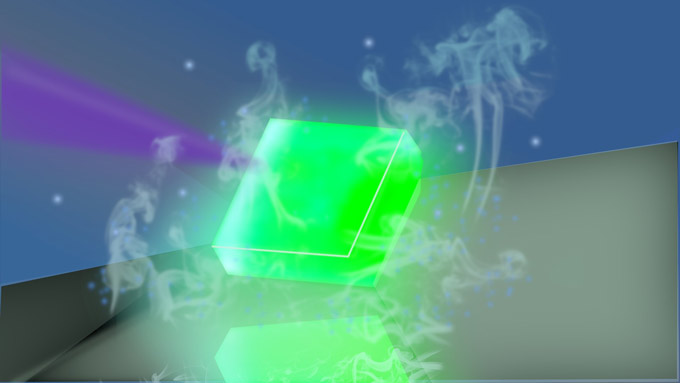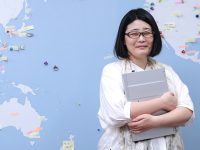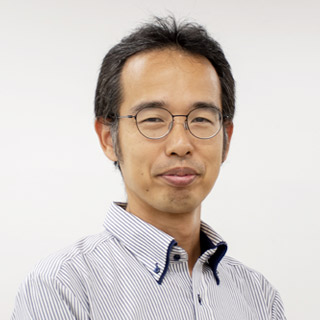Researchers investigate an elusive cooling phenomenon in a halide perovskite-based “dots-in-crystal” material, shedding light on its strengths and limitations
In a recent study, researchers from Chiba University delved into a promising path toward solid-state optical cooling using perovskite quantum dots. Focused on anti-Stokes photoluminescence, a process in which materials emit higher-energy photons than they absorb, this research could revolutionize the existing cooling technology. Their findings highlight both the potential and limitations of this novel cooling approach, with exciting prospects in energy-saving technology.

Image title: Demonstration of optical cooling in semiconductor quantum dots
Image caption: Researchers from Japan experimentally demonstrate how perovskite quantum dots contained in a crystal lattice can reach temperatures of about 10 K below room temperature via optical cooling, paving the way for energy-efficient cooling technologies
Image credit: Dr. Yasuhiro Yamada from Chiba University, Japan
Image license: Original content
Usage restrictions: Cannot be used without permission
Cooling systems are an integral part of many modern technologies, as heat tends to wear down materials and decrease performance in several ways. In many cases, however, cooling can be an inconvenient and energy-intensive process. Accordingly, scientists have been seeking innovative and efficient methods to cool substances down.
Solid-state optical cooling is a prominent example that leverages a very unique phenomenon called anti-Stokes (AS) emission. Usually, when materials absorb photons from incoming light, their electrons transition into an “excited” state. Under ideal conditions, as electrons return to their original state, part of this excess energy is released as light, while the rest is converted into heat. In materials that undergo AS emission, electrons interact with crystal lattice vibrations called “phonons” in such a way that the photons emitted are of higher energy than those in the incident light. If AS emission efficiency is close to 100%, these materials could theoretically cool down, rather than heating up, upon exposure to light.
In a recent study published on August 29, 2024, in Volume 24, Issue 36 of Nano Letters, a team of researchers led by Professor Yasuhiro Yamada from the Graduate School of Science, Chiba University, Japan, delved deep into this phenomenon in a promising perovskite-based material structure. This team, which included Takeru Oki from the Graduate School of Science and Engineering, Chiba University, Dr. Kazunobu Kojima from the Graduate School of Engineering, Osaka University, and Dr. Yoshihiko Kanemitsu from the Institute for Chemical Research, Kyoto University, sought to shed light on the optical cooling phenomena in a special arrangement of perovskite quantum dots (extremely small CsPbBr3 crystals) embedded within a Cs4PbBr6 host crystal matrix (indicated as CsPbBr3/Cs4PbBr6 crystal).
“Efforts to achieve optical cooling in semiconductors have encountered several difficulties, primarily due to challenges in reaching nearly 100% emission efficiency, and true cooling has been elusive. Though quantum dots are promising for their high emission efficiency, they are notoriously unstable, and exposure to air and continued illumination degrade their emission efficiency. Thus, we focused on a stable structure known as ‘dots-in-crystals,’ which may overcome these limitations,” explains Yamada.
Using semiconducting quantum dots presents an unsolved problem. When light irradiates a semiconductor, it generates excitons—pairs of electrons and positively charged “holes.” When excitons recombine, they typically emit light. However, at high exciton densities, a process called Auger recombination becomes more prominent, by which energy is released as heat instead of light. In semiconductor quantum dots, irradiation with high-intensity light often leads to heating instead of cooling because of this process.
Thus, the researchers used time-resolved spectroscopy to determine the conditions under which Auger recombination occurred more frequently. These experiments showed that heating was unavoidable even at moderate light intensities, implying that experiments under low-intensity light were required to observe true optical cooling. Unfortunately, at low intensities, optical cooling becomes less effective. Under the best conditions, their sample demonstrated a theoretical cooling limit of approximately 10 K from room temperature.
Another focal point of the study was to make more reliable temperature measurements than in previously reported efforts. To this end, they developed a method to estimate the temperature of samples with high emission efficiency by analyzing the shape of their emission spectrum. True optical cooling was observed in multiple samples, and the researchers noted that a transition from cooling to heating occurred as the excitation light intensity was increased. “Previous reports of optical cooling in semiconductors lacked reliability, primarily due to flaws in temperature estimation. Our study, however, not only established a reliable method, but also defined the potential and limitations of optical cooling through time-resolved spectroscopy, marking a significant achievement in the field,” remarks Yamada.
This study paves the way for future research focused on minimizing Auger recombination to improve the cooling performance of dots-in-crystal arrangements. If optical cooling improves significantly to reach widespread practical use, it could become the foundation of several energy-saving technologies, contributing to global sustainability goals.
About Professor Yasuhiro Yamada from Graduate School of Science, Chiba University
Dr. Yasuhiro Yamada, a leading researcher at the Graduate School of Science, Chiba University, Japan, has made substantial contributions in the fields of materials science, semiconductor physics, and laser spectroscopy. His work focuses on the fundamental optical properties and carrier recombination dynamics of perovskite materials. Through his research, Prof. Yamada has enhanced the scientific community’s understanding of exciton dynamics, electron-phonon interactions, and the optical functionalities of perovskite semiconductors. His work has paved the way for advancements in optoelectronics, with practical applications in energy and cooling technologies.
Funding:
This research work is supported by Canon Foundation, the International Collaborative Research Program of Institute for Chemical Research, Kyoto University (Grant No. 2023-21), JST-CREST (Grant No. JPMJCR21B4), and KAKENHI (Grant No. JP19H05465).
Reference:
Title of original paper: Optical Cooling of Dot-in-Crystal Halide Perovskites: Challenges of Nonlinear Exciton Recombination
Authors: Yasuhiro Yamada1, Takeru Oki1, Takeshi Morita1, Takumi Yamada2, Mitsuki Fukuda3, Shuhei Ichikawa3, Kazunobu Kojima3, and Yoshihiko Kanemitsu2
Affiliations:
1Graduate School of Science, Chiba University
2Institute for Chemical Research, Kyoto University
3Graduate School of Engineering, Osaka University
Journal: Nano Letters
DOI: 10.1021/acs.nanolett.4c02885
Contact: Yasuhiro Yamada
Graduate School of Science, Chiba University
Email: yasuyamada@chiba-u.jp
Public Relations Office, Chiba University
Address: 1-33 Yayoi, Inage, Chiba 263-8522 JAPAN
Email: koho-press@chiba-u.jp
Tel: +81-43-290-2018
Osaka University
Address: 2-1 Yamadaoka, Suita, Osaka 565-0871 Japan
Email: kou-soumu-hyoukakouhou@office.osaka-u.ac.jp
Global Communications, Kyoto University
Address: Yoshida-honmachi, Sakyo-ku, Kyoto 606-8501 Japan
Email: comms@mail2.adm.kyoto-u.ac.jp
Tel: +81-75-753-5727
Recommend
-

On the Road to Establishing a Performing Arts Medicine Center: Specialized Doctors for Musicians and Ballet Dancers
2023.06.02
-

The role of the Research Institute of Disaster Medicine (RIDM): The indispensable research hub for urban digital transformation
2023.02.23
-

Navigating the Society-driven Research: PPI and the Quest for Research Integrity
2025.02.27


